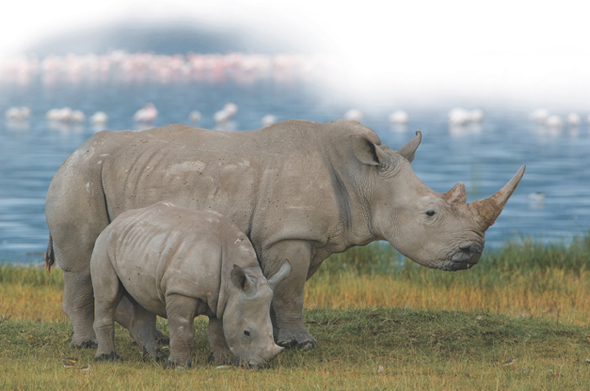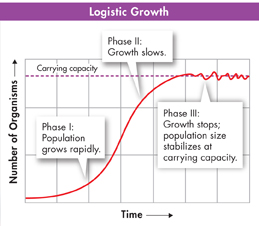Logistic Growth
 What is logistic growth?
What is logistic growth?
This ability of populations to grow exponentially presents a puzzle. Obviously, bacteria, elephants, hydrilla, and gypsy moths don't cover the Earth. This means that natural populations don't grow exponentially for long. Sooner or later, something—or several “somethings”—stops exponential growth. What happens?
VISUAL SUMMARY
LOGISTIC GROWTH
Phases of Growth One way to begin answering this question is to watch how populations behave in nature. Suppose that a few individuals are introduced into a real-world environment. Figure 5–5 traces the phases of growth that the population goes through.
▸ Phase 1: Exponential Growth After a short time, the population begins to grow exponentially. During this phase, resources are unlimited, so individuals grow and reproduce rapidly. Few individuals die, and many offspring are produced, so both the population size and the rate of growth increase more and more rapidly.
▸ Phase 2: Growth Slows Down. In real-world populations, exponential growth does not continue for long. At some point, the rate of population growth begins to slow down. This does not mean that the population size decreases. The population still grows, but the rate of growth slows down, so the population size increases more slowly.
▸ Phase 3: Growth Stops. At some point, the rate of population growth drops to zero. This means that the size of the population levels off. Under some conditions, the population will remain at or near this size indefinitely.

Table of Contents
- Formulas and Equations
- Applying Formulas and Equations
- Mean, Median, and Mode
- Estimation
- Using Measurements in Calculations
- Effects of Measurement Errors
- Accuracy
- Precision
- Comparing Accuracy and Precision
- Significant Figures
- Calculating With Significant Figures
- Scientific Notation
- Calculating With Scientific Notation
- Dimensional Analysis
- Applying Dimensional Analysis





